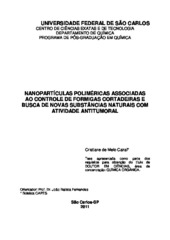Nanopartículas poliméricas associadas ao controle de formigas cortadeiras e busca de novas substâncias naturais com atividade antitumoral
Abstract
PART I: Polymeric nanoparticles and bioassay-guided phytochemical investigation of Trichilia elegans e Trichilia catigua (Meliaceae) for the control of leaf-cutting ants Leaf-cutting ants are known as severe agricultural pests. Several compounds have been proposed for their control such as organophosphorus, pyrethroids and sulfluramid insecticides. However, non-target animals and environmental contamination are common problems and therefore new strategies to control these pests have been requested. In this context, this work involved the bioassay-guided study of T. elegans e T. catigua (Meliaceae) and also the development and characterization of three different nanoparticles, containing either ricinine, xanthyletin or rauianin for the control of leaf-cutting ants. Phytochemical investigations from active extracts and fractions have allowed to isolate 23 compounds (3 new), including sterols, coumarins, phenolic compounds, oxazol derivative, flavonoids and limonoids. The compound 3-(4'-hydroxyphenyl)-2-propenoic acid (4''-carboxyl)-phenyl ester (14), from T. elegans, showed high biologic activity against leaf-cutting ants. Additionally, the limonoid cedrelone, from T. catigua, was active against the symbiotic fungus of leaf-cutting ants (L. Leucoagaricus gongylophorus). The solvent displacement technique adopted here showed to be very efficient for the preparation of nanoparticle formulations containing either xanthyletin or rauianin. In addition, a novel method was developed for the encapsulation of ricinine. These natural insecticides were nanoencapsulated for the first time and the results observed here showed a better activity, more water dispersivity and stabilization of nanoparticles if compared to free compounds.
